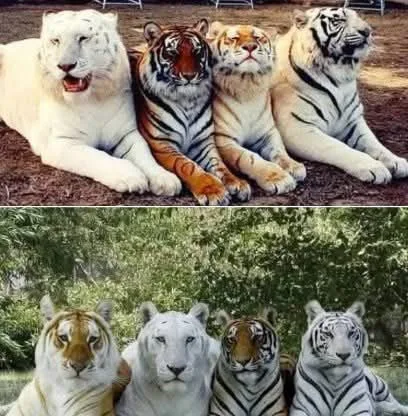Look at the image above. In it, four magnificent tigers are captured, a sight so rare it serves as a potent and silent reminder of the incredible biodiversity we are on the verge of losing. These aren’t just any tigers; they represent the stunning variations within the tiger species (Panthera tigris) – variations that are increasingly threatened and edging closer to disappearing forever in the wild.

For many, the Bengal tiger (Panthera tigris tigris) is the quintessential image of power and majesty. Famous across the globe, this iconic subspecies once roamed vast territories across several countries. Yet, the stark reality is that the Bengal tiger is now endangered. Relentless poaching and the devastating loss of their natural habitats have taken an immeasurable toll on their populations. Their stripes, once a common sight, are becoming tragically scarce.
Beside them, the ethereal beauty of the White tiger commands attention. A genetic mutation of the Bengal tiger, white tigers are a truly rare sight in the wild. Their striking white fur, while captivating to our eyes, offers little camouflage in their natural environment. Consequently, the majority of white tigers alive today reside in captivity, often the result of selective breeding programs. While their beauty is undeniable, their prevalence in captivity serves as a somber reminder of their dwindling wild numbers.
Then there’s the almost mythical Golden tiger, also known as the Golden Tabby tiger. This breathtaking genetic variant, again primarily found within the Bengal tiger population, is characterized by its pale gold or cream-colored fur and reddish-brown stripes. With estimates suggesting fewer than 30 living individuals, mostly in captivity, this stunning variation is exceptionally rare. While the text mentions “crossbreeding” as a factor, it’s more accurate to say their existence in captivity is maintained through specific, and sometimes controversial, breeding efforts. Their rarity underscores the fragility of genetic diversity.
And perhaps the rarest of them all, the White tiger with golden stripes. This incredible combination of two recessive genes results in an almost completely white tiger with pale golden or light brown stripes. Sightings in the wild are virtually non-existent, and this breathtaking creature exists almost exclusively within the confines of zoos and private collections. Their extreme rarity is a stark illustration of how genetic variations can become increasingly vulnerable and reliant on human intervention for survival.
The presence of these magnificent variations together in one image isn’t just visually stunning; it’s a powerful symbol of what we stand to lose. These aren’t separate species, but unique expressions of a single, awe-inspiring creature. The dramatic decline of all tiger populations, including these rare color morphs, is a deafening alarm bell. Habitat destruction, human-wildlife conflict, and the insatiable demand of the illegal wildlife trade are pushing these incredible animals towards the brink.
We stand at a critical juncture. The potential silencing of the tiger’s roar in the wild is a tragic prospect. Losing these magnificent big cats would not only be an ecological disaster, disrupting delicate ecosystems, but also a profound cultural loss for many societies around the world.
The time for complacency is over. We must act now, with urgency and determination, to support and implement effective conservation measures. This includes:
- Strengthening anti-poaching efforts: Protecting tigers from those who seek to profit from their demise.
- Preserving and restoring their natural habitats: Ensuring they have safe and sufficient spaces to live and breed.
- Combating the illegal wildlife trade: Dismantling the networks that fuel the demand for tiger parts and products.
- Supporting conservation organizations: Contributing to the vital work they do on the ground.
- Raising awareness and educating communities: Fostering a culture of respect and understanding for these magnificent animals.
Let the sight of these rare tigers not just be a beautiful image, but a catalyst for change. Let it ignite a collective passion to protect these incredible creatures before they become nothing more than a fading memory, a story we tell our grandchildren about the majestic roar that once echoed through the forests. The future of these magnificent tigers, in all their breathtaking variations, rests in our hands. Let’s ensure their roar continues to echo for generations to come.





